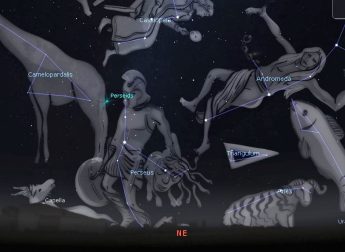This Week’s Sky at a Glance, 2024 August 10 – August 17
This Week’s Sky at a Glance, 2024 August 10 – August 17
You can see a few meteors per hour on any night in a clear, dark sky, but the number increases greatly when Earth passes through a trail of pebbles and dust left by a comet that makes frequent orbits around the Sun. The pebbles left by comet Swift-Tuttle in its 133-year orbit are quite large at a few centimetres, and they enter our atmosphere at a high relative velocity of 60 km/s (Earth travels at 30 km/s). Therefore, they can be very bright. The Perseids will seem to be coming from a point between the constellations Perseus and Cassiopeia, which are highest in the sky in early morning. You will see fewer in the evening but they tend to be long and bright.
Meteors, also called shooting stars or falling stars, are the streaks of light created when pebbles enter the atmosphere at an altitude of about 100 kilometres, and those particles from comets disintegrate before they reach an altitude of 50 kilometres. Many meteors are faint and easily made invisible by moonlight and light pollution. This weekend the Perseid shower occurs with the Moon nearing first quarter and approaching the low point of the ecliptic, making for early setting times. Get comfortable in a chair, have extra clothes or blankets if you plan to stay long as it can get very chilly, and select a patch of sky that is free of clouds and direct light. It is better to keep Perseus to your side rather than look in that direction because the meteors will look more spectacular, covering a longer distance.
This Week in the Solar System
Saturday’s sunrise is at 6:20 and sunset will occur at 8:38, giving 14 hours, 18 minutes of daylight. Next Saturday the Sun will rise at 6:28 and set at 8:27, giving 13 hours, 59 minutes of daylight.
The Moon is at first quarter on Monday, setting before midnight to provide a moonless night for the meteor shower, and it is near Antares on Tuesday. Mars and Jupiter draw the attention midweek, rising around 1 am with Mars half a degree (a Moon-width) above Jupiter on Wednesday and one degree to Jupiter’s left Thursday. Saturn rises before 10 pm this week, while Venus sets about 45 minutes after sunset. Mercury is out of sight, setting around sunset. The Perseid meteor shower will be at its best after midnight Monday morning but watching a day or two either side of that is worthwhile.
The annual Mount Carleton Star Party this weekend has been cancelled due to the untimely arrival of Debby.

